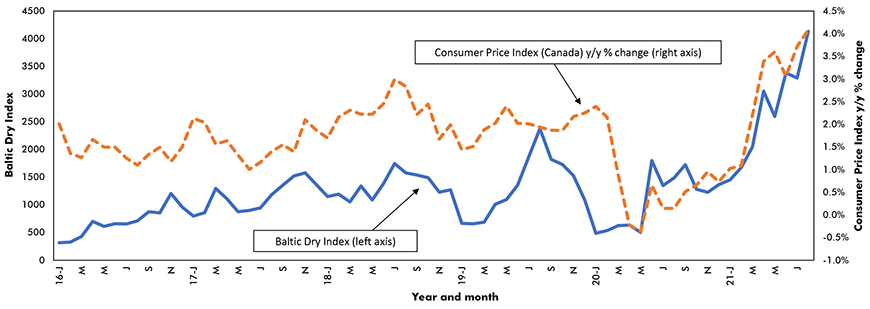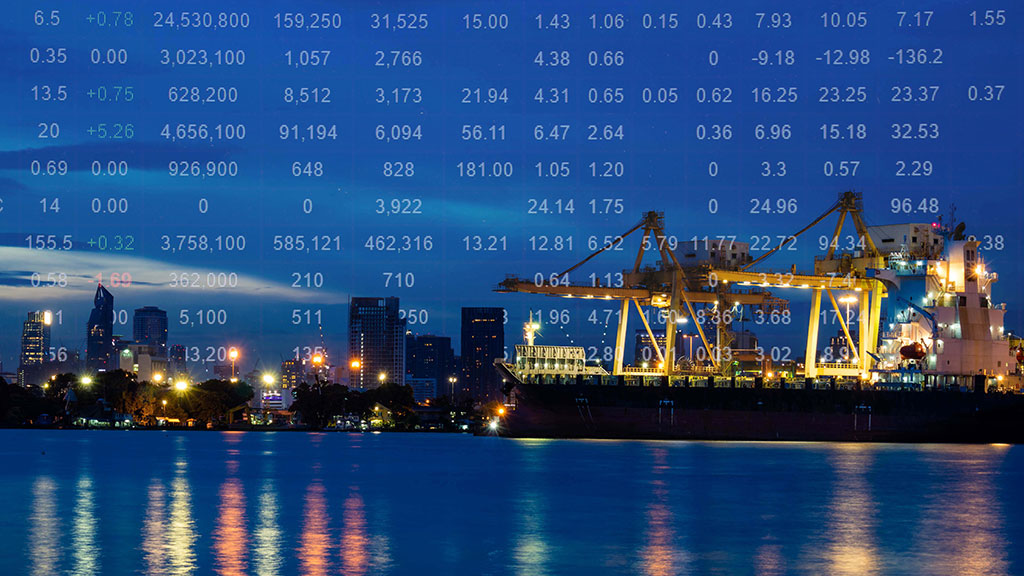With many of the negative economic impacts of COVID-19 finally receding, surging demand has put global supply chains under extreme stress. Rising demand for commodities such as iron ore, metallurgical coal, corn, and wheat has caused the Baltic Dry Index, which tracks international ocean freight rates, to jump from 540 in early 2020 to a ten-year high of 4,000 in the middle of this year. While this climb is due in large part to China’s expanding appetite for raw materials, it has been augmented by a vaccine-fuelled increase in global growth.
Strong global post-pandemic demand + shortage of ships = record freight costs
Driven by strong demand for manufactured goods, most of which are sourced in Asia, the Freightos’ Baltic Index, the leading international freight rate index (i.e., it tracks the average price to ship a standard 40-foot container) has risen from $1,461 at the beginning of 2020 to $11,109 in September of this year. An acute shortage of ocean transportation capacity is restricting U.S. and Canadian import flows from Asia. As a result, the Freightos’ China/East Asia to North America sub-index hit an off-the-charts $22,173 in early September, more than twice its print at the beginning of July of this year. The most recent surge in the pricing of containers comes on the back of the Suez Canal blockage in March which tied up approximately 321 ships for 14 days.
Due to supply-chain bottlenecks at ports in Los Angeles and Long Beach, that together handle approximately one-third of U.S. imports, a record 55 container ships are at anchor waiting to be unloaded. According to the National Retail Federation, “the bulk of the upturn in U.S. inflation has been driven by supply chain bottlenecks and low levels of inventories.”
In Canada, the Port of Vancouver is also experiencing longer than usual line-ups of ships waiting to be unloaded. According to Omnitrans customs brokers, vessel wait times have increased to 5-7 days with frequent delays of 5 days to two weeks to load containers onto rail. In line with U.S. west coast ports, the cost to ship a 40-foot container from China to Vancouver has risen to record levels over the past 12 months.
Consumer price inflation in Canada and the U.S. hit multi-year highs in mid-2021
On both sides of the border, the impact of supply chain bottlenecks is spreading to consumers. In the U.S., the consumer price index has accelerated from +1.3% y/y to +5.3% y/y over the past 12 months. While a portion of this increase is the result of a post-pandemic surge in energy prices, a recent Wall Street Journal article noted that “leaders of some of the busiest U.S. ports expect congestion snarling maritime gateways to continue deep into next year”. Given the acceleration in the consumer price index and the prospect of persisting supply bottlenecks, it is not surprising that the Federal Reserve of New York’s Survey of Consumer Expectations found that short and long-term inflation expectations hit series highs of +5.2% y/y and +4.2% y/y respectively in August.
In Canada, the combination of supply chain bottlenecks and higher energy costs pushed import prices up by +3.8% y/y in July from -0.3% y/y 12 months prior. At the consumer level, Canada’s all-items Consumer Price Index has accelerated from -0.4% y/y in May of 2020 to an 18-year high of +4.1% y/y this August.
Given the strong linkages between economic activity in Canada and the United States, the persisting effect of global supply chain bottlenecks noted above will probably maintain upward pressure on consumer prices in Canada well into 2022. As in the U.S., this prospect is reinforced by two recent forward-looking surveys of inflation expectations. First, the August Business Barometer published by the Canadian Federation of Independent Business reported average pricing plans hit a 12-year high of +3.8% y/y, up from +2.1% at the beginning of this year. Second, according to the most recent (Q2/2021) Bank of Canada Business Outlook Survey, the percentage of respondents expecting inflation over the next two years to average above +2.0% hit a 16-year high of 86%.
As noted in Snapshot #14 titled High inflation raises risk of higher interest rates, it is still quite possible the global commodity price surge will ease, thereby taking pressure off consumer prices and reducing the risk that central banks will be forced to tighten in the second half of 2022. However, the above-noted prospect of persisting global supply chain bottlenecks reinforces the view that central banks will be forced to dampen inflationary expectations by tightening monetary policy sooner than they currently plan.
John Clinkard has over 35 years’ experience as an economist in international, national and regional research and analysis with leading financial institutions and media outlets in Canada.
Baltic Dry Index vs Y/Y% change in the Consumer Price Index (Canada)

Chart: ConstructConnect – CanaData.
Please click on the following link to download the PDF version of this article:
Economic Snapshot Vol. 19, Issue 18 – Supply chain bottlenecks raise risk of higher interest rates – PDF










We need more and better truck parking in Ont and B C . We need min wage and treatment of all people working in transport and insurance for new drivers and training schools in Ontario. We also need better medical care and place for drivers to stay between trips now that many homeless shelters are turning sick truck drivers away if not will will become like the U K